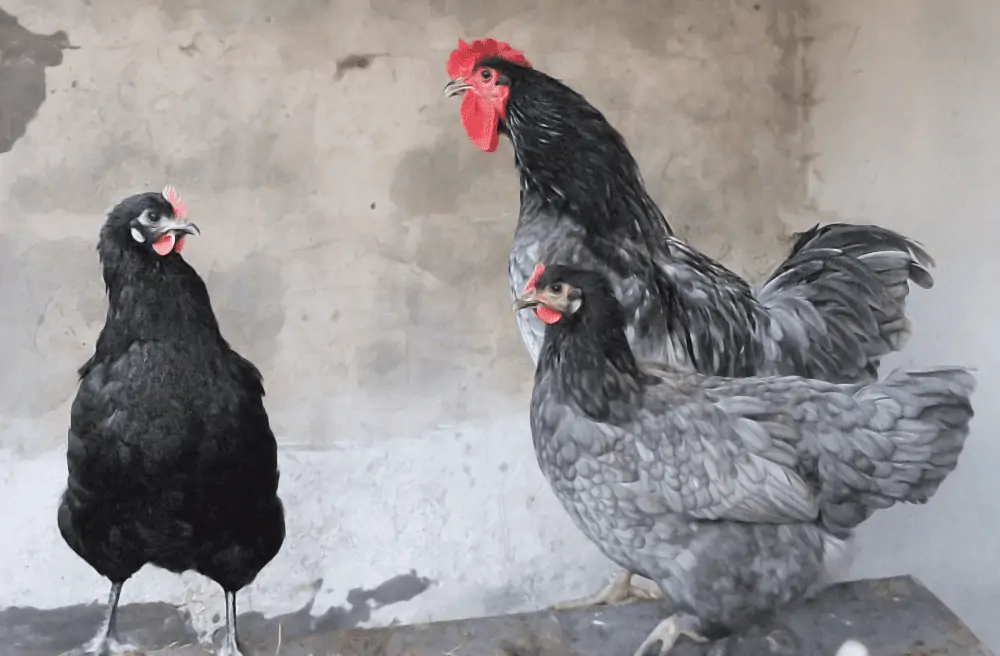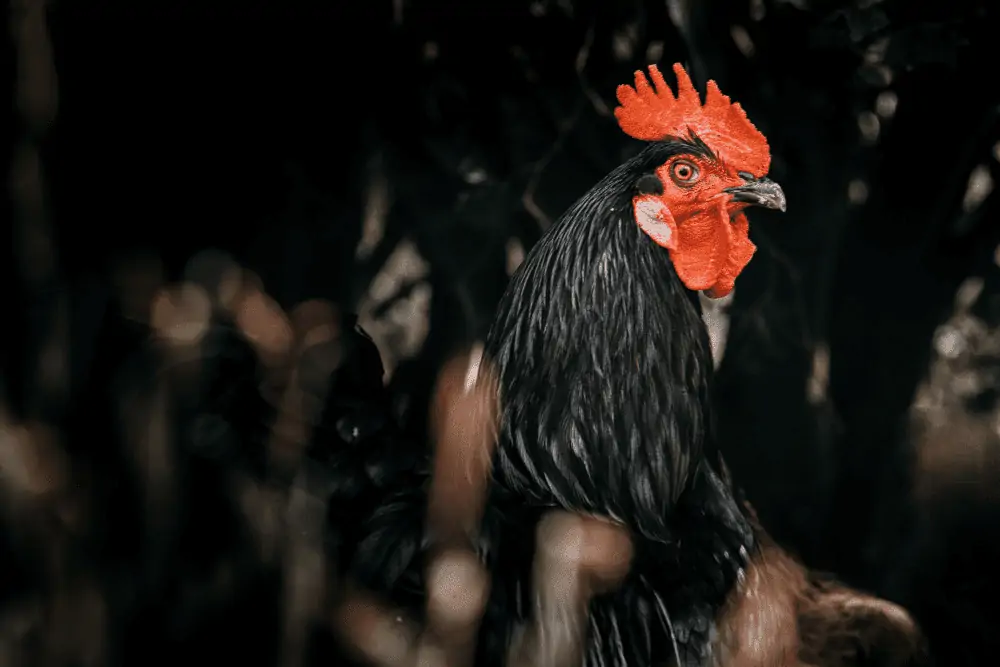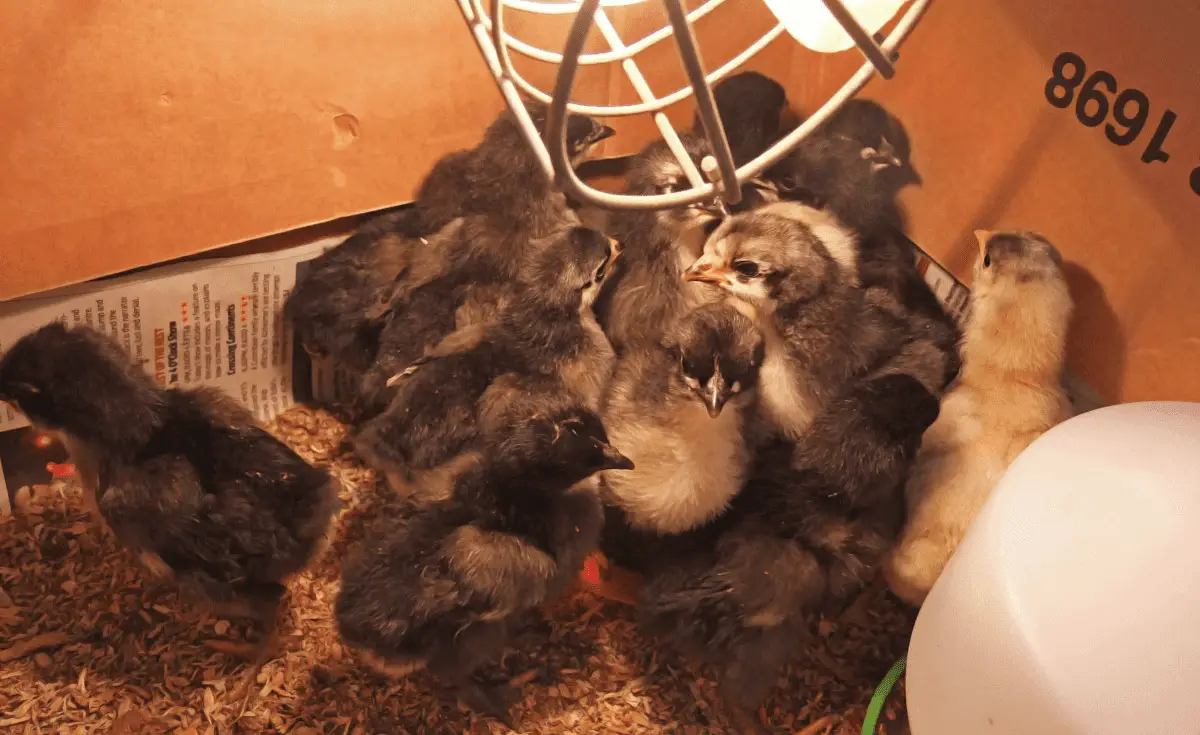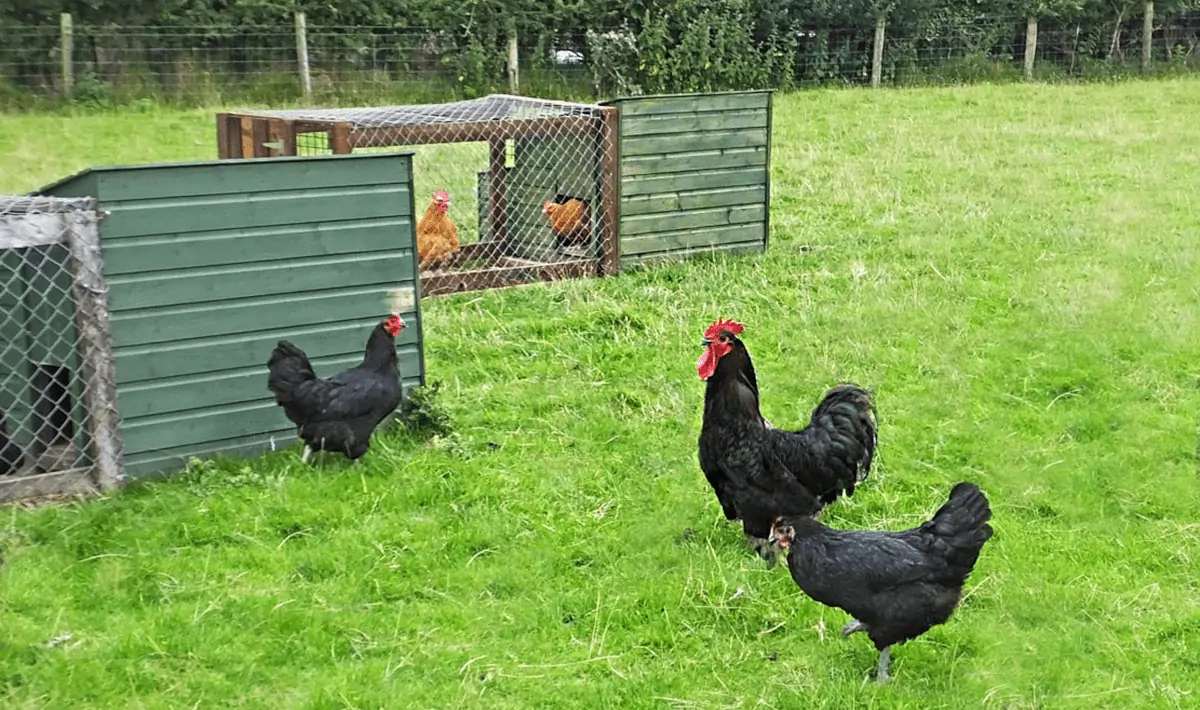When it comes to chickens, big certainly is beautiful. And among the biggest of the big is the Jersey Giant chicken.
These gentle giants were originally bred in New Jersey in the late 1800s for two primary reasons: to provide a large amount of meat for families and to replace turkeys on farms.
Standing as tall as 2 ft. 20 in, these chickens are truly a sight to behold! While they may not be as popular as they once were, Jersey Giants still make excellent egg-layers and interesting additions to any flock. Read on to learn more about this amazing breed of chicken.
- What Is the Largest Breed of Chicken?
- Background and History of Jersey Giant Chickens
- Appearance and Size of the Jersey Giant
- Jersey Giant Temperament and Personality
- Price of a Jersey Giant
- Are Jersey Giants Good Meat Chickens?
- Jersey Giant Egg laying
- Health Issues to Be Aware Of
- Jersey Giant Chicken Care Guide
- Breeding Jersey Giant Chicks
- Pros and Cons of Raising Jersey Giants
What Is the Largest Breed of Chicken?
As you might have already guessed, The Jersey Giant is the largest chicken breed in the world, known for its impressive size and weight. These birds can reach up to 12 pounds for hens and 15 pounds for Jersey Giant roosters, making them the largest breed of chicken in the world.
However, it’s important to note that there are other large chicken breeds as well, such as the Brahma, Cochin, and Plymouth Rock, though these breeds are not quite as large as the Jersey Giant.
It’s also worth noting that the Black Australorp is another black chicken breed that is often confused with the Black Jersey Giant. The Black Australorp is a medium to large-sized breed, reaching an average weight of 6-8 pounds for roosters and 5-7 pounds for hens.
While both the Black Australorp and the Jersey Giant are black chicken breeds with very similar coloring and features, the Jersey Giant is significantly larger and heavier than the Black Australorp.
There is also a subtle difference between the Black Australorp and the Black Jersey Giant in their skin and foot coloring. The Australorp has white skin and gray toes with white to gray under the feet, while Black Jersey Giants have yellow skin with black or yellowish toes and yellow under their feet.
Background and History of Jersey Giant Chickens
The Jersey Giant breed was developed in Burlington County, New Jersey, by John and Thomas Black in an attempt to create the perfect chicken for meat production. To achieve this, they cross-bred several large breeds of chickens, including the Brahma, Cochin, Langshan, and Plymouth Rock.
The first generation of Black’s chickens—which he dubbed “Black Giants”—exceeded his expectations, with many roosters weighing in at 13 pounds or more.
However, while these birds were significantly larger than other chickens of the time, they were also very slow-growing and difficult to raise. As a result, Thomas Black set out to create a second generation of birds that would grow just as large but would be more robust and easier to raise.
After several years of selective breeding, he finally achieved his goal and named his new chicken the “Jersey Giant” in honor of its place of origin.
Endangered Status
Sadly, due largely to their declining popularity among commercial poultry farmers, the Jersey Giant chicken is currently on The Livestock Conservancy’s Conservation Priority List.
This means that the breed is at risk of becoming extinct if action is not taken to preserve it. One way you can help preserve this amazing breed is by raising a few of them in your own backyard. To do so, you’ll need to find a breeder or hatchery that specializes in Jersey Giants.
Additionally, you can also consider getting involved with The Livestock Conservancy. Or you can join the American Poultry Association (APA), a nonprofit organization dedicated to promoting and preserving all poultry breeds, including the Jersey Giant.
The APA maintains accurate and up-to-date breed standards for all recognized poultry breeds and educates the public about the importance of preserving genetic diversity in poultry.
By becoming a member of The Livestock Conservancy or the APA and supporting their efforts, you can contribute to the conservation and promotion of the Jersey Giant and other at-risk poultry breeds.
Appearance and Size of the Jersey Giant
As their name suggests, these are absolutely massive birds. In fact, they are the largest purebred chicken in existence! Jersey Giant roosters typically weigh between 12 and 15 pounds, while Jersey Giant hens tend to weigh between 10 and 12 pounds. That is almost double the weight of the average chicken.
This gentle giant will stand 22-26 inches tall and has a broad, sturdy body and long legs. They are a single-comb breed and have yellow skin, red earlobes, and dark brown eyes.
It should also be noted that a bantam version of the Jersey Giant chicken exists, which has all the same characteristics as their full-sized counterparts but is less than 1/4 the size.
The most common plumage color is black, but the breed also comes in blue and white. Sometimes they are simply called Black/White/Blue Giants, but they are all Jersey Giants. The American Poultry Association recognizes all three colors.
Black Jersey Giants
This is the original Jersey Giant chicken. It has beautiful green sheen plumage and dark eyes. The shanks and toes are black, except for the yellow skin on the bottom of the feet. The Black Jersey Giants are the largest of the three.
Blue Jersey Giants
Blue Jersey Giants are relatively new. They were developed by breeding a Blue Andalusian rooster to Black Giants hens. The result is a chicken that looks similar to the Black Giants but with blue plumage instead of black.
White Jersey Giants
The white Giant was created by cross-breeding several large chicken breeds. Like the Blue Giant, it resembles the Black Jersey Giant chicken but with white plumage instead of black. White Giants are usually smaller than the other two color variations.

Jersey Giant Temperament and Personality
Despite their size, Jersey Giants are actually quite docile birds with calm dispositions. They are generally easy to handle and make great pets for families with children. They are also known for their intelligence and can be trained to do a variety of tasks, such as coming when called or following commands.
The Jersey Giant rooster is typically not aggressive, although all roosters may exhibit some territorial behavior and protectiveness over their flock. If you are keeping a Jersey Giant rooster in your flock, it’s always important to monitor their behavior and intervene if necessary to prevent aggression towards humans or animals.
Jersey Giants and other Chickens
Jersey Giants generally get along well with other chickens, although there may be occasional instances of aggression or pecking order dynamics, as is common in any flock of chickens. It’s important to provide enough space, food, and resources for all of your chickens to avoid conflicts.
However, as mentioned earlier, the temperament and personality of individual chickens can vary, and environmental factors such as how the chickens are raised and socialized can also affect their temperament.
Price of a Jersey Giant
The price of a Jersey Giant chicken will vary depending on a number of factors, including the location, age, and genetic purity. Generally, you can expect to pay somewhere around $3 to $6 for a young, unsexed Jersey Giant chick through an online hatchery.
The price for a fully grown, adult Jersey Giant will usually be in the range of $10 to $50, depending on the specific characteristics of the bird and its age. It’s worth noting that the price can also vary depending on the time of year and local demand for the birds.
Where to Get Jersey Giants?
If you are looking to purchase Jersey Giants, there are a number of options you can consider. One option is to visit a local farm or feed store to see if they have Jersey Giants for sale.
You may also be able to find breeders or hatcheries that specialize in Jersey Giants by searching online or asking for recommendations from other chicken enthusiasts. Local farming or homesteading groups or forums may also be a good resource for finding Jersey Giants for sale.
Another option is to check with local chicken rescues or shelters. These organizations often have a variety of breeds available for adoption, including Jersey Giants. Adopting a chicken from a rescue can be a rewarding way to add a new member to your flock while also supporting a good cause.
It’s important to carefully evaluate the seller and the birds before making a purchase to ensure that you are getting a healthy, well-cared-for chicken. You may want to ask the seller questions about the bird’s health history, diet, and living conditions, and consider having a veterinarian or other expert check the bird before making a purchase.
Are Jersey Giants Good Meat Chickens?
As someone who has experience with Jersey Giants, I can tell you that they can definitely be eaten. They are a large breed of chicken with a good amount of meat on their bones, so they could potentially be used as meat birds if that is something you are interested in.
However, Jersey Giants are not typically considered to be the best choice for meat production. Like most heritage breeds, they are dual-purpose chickens, meaning they are raised for both eggs and meat, while not perfect for either.

Jersey Giants have a relatively high feed conversion ratio compared to most other breeds. They also grow relatively slowly and can eat a lot, which makes them less cost-effective as a meat chicken compared to other breeds.
Personally, I don’t keep Jersey Giants for the purpose of meat production. While they do have a good amount of meat on their bones, I find that their slow growth and high feed requirements make them less cost-effective as a meat bird compared to other breeds.
However, I do enjoy the meat, and they could potentially be used as a meat bird if that is something you are interested in. Ultimately, the decision of whether or not to use Jersey Giants as a meat bird will depend on your specific circumstances and goals.
Jersey Giant Egg laying
Jersey Giant chickens are highly regarded for their egg-laying abilities, and in my experience, they live up to their reputation. As mentioned, these birds are considered to be dual-purpose. In terms of egg production, Jersey Giant hens will produce a good number of large brown eggs, averaging around 220 per year.
In my flock, I have found that Jersey Giant hens typically start laying eggs at around ten months of age, although this can vary depending on the individual bird and environmental factors such as diet and lighting.
Jersey Giants eggs are very large, with a weight of 2.5 up to 3 ounces. All Jersey Giants lay brown eggs regardless of their color. Some individuals may lay eggs that are slightly darker or lighter in color, but that’s not related to their feather coloring.
In terms of egg production, I would definitely consider Jersey Giants to be a good choice. They produce a good number of large, high-quality eggs and have a relatively long lifespan, which makes them a good investment for those interested in raising chickens for eggs.
However, I should remind you that these birds do tend to eat a lot, which can make them less cost-effective for large-scale egg production.
If you are planning to make a business out of egg production, you may want to consider other breeds that are more efficient at converting feed into eggs. However, for those looking for family friends and reliable layers for their backyard or homestead, Jersey Giants can be a great choice.
Health Issues to Be Aware Of
Jersey Giant chickens are a hardy breed and easy to keep when it comes to health issues. However, like all chickens, they can be prone to certain problems from time to time.
One potential health concern for Jersey Giant is leg injuries, which can occur when the bird jumps out of the air and lands poorly. Because of their size and weight, Jersey Giants will be more at risk of this type of injury compared to smaller breeds.
Here are a few things you can do to help protect your birds from leg injuries:
Provide plenty of bedding or sand in the coop and run to help cushion their landings and reduce the risk of leg injuries.
Make sure the coop and run are free of hazards that could cause leg injuries, such as sharp objects or debris.
Keep an eye on your chickens and intervene if you see any behavior that could lead to leg injuries, such as fighting.
Another important consideration for Jersey Giants is their need for plenty of space to move around and stretch their wings.
These birds are large and need ample room to roam and engage in natural behaviors such as scratching and dust bathing. It’s important to provide a coop and run that are large enough to accommodate their size, or consider allowing them to free-range in a securely fenced area.
Overall, Jersey Giant chickens are a healthy breed, and you can expect them to live long and happy lives.
Jersey Giant Chicken Care Guide
Jersey Giants are generally easy to keep and make a great addition to any backyard flock. With their calm dispositions, prolific egg-laying abilities, and delicious meat, they are sure to become a favorite among chicken enthusiasts.
However, as with any animal, it’s important to understand their needs and how to care for them properly to ensure they live long and healthy lives. Here are some key points to consider when it comes to caring for Jersey Giant chickens:
Run and Roam
Due to their large size, Jersey Giants need plenty of space to move around and stretch their wings. It’s a good idea to provide at least 10 to 20 square feet of outdoor space per chicken in the run.
Consider letting your girls free range in a secure area during the day. This will give them the opportunity to engage in natural behaviors such as scratching and dust bathing, which can help keep them happy and healthy.
Coop Setup
When it comes to the coop, it’s just as important to provide plenty of space for your Jersey Giants to sleep and roost. Aim for at least 4 to 5 square feet of indoor space per chicken.
It’s also a good idea to provide plenty of bedding or sand to cushion their feet and keep them comfortable.
As with all chicken coops, it should be well-ventilated to help prevent the buildup of harmful gases and odors, but it should also be draft-free to keep your birds warm and cozy. Be sure to include a secure door or gate to keep your chickens safe from predators at night.
Feeding
The Jersey Giant chicken is a very hearty eater, and they need a balanced diet to stay healthy.
A good quality commercial chicken feed will provide the nutrients they need, but you can also make your own chicken mix and supplement their diet with treats such as scratch, grains, vegetables, and kitchen scraps.
It’s important to provide clean, fresh water at all times, and consider using a hanging feeder or other types of feeders that is out of reach of rats and other rodents to help prevent contamination.
If your chickens don’t have access to grit in their environment (such as sand or small pebbles), you should also provide a grit supplement to help them digest their food properly.
Breeding Jersey Giant Chicks

If you’re interested in breeding Jersey Giant chicks, there are a few things to keep in mind:
Egg Incubation
Incubating eggs from Jersey Giant chickens is generally similar to hatching eggs from other chicken breeds (here is a great guide).
However, it’s important to note that the incubation period may be slightly longer for Jersey Giant eggs, taking one to two days more than the usual 21 days. So don’t be too worried if your chicks don’t start hatching right on day 21.
Brooder
Once the baby chicks hatch, they will need to be kept in a brooder until they are old enough to be moved to a coop. Since Jersey Giant chicks grow to be pretty large, you might want to consider using a larger brooder than you would for other chicken breeds.
The brooder should be a warm and safe place for your chicks to grow and develop, with plenty of bedding or sand to keep them comfortable.
It’s important to provide a heat source to keep the chicks warm and monitor the temperature to ensure it stays within the appropriate range for their age.
Pros and Cons of Raising Jersey Giants
Overall, Jersey Giant chickens are a delightful breed with many attractive qualities. They are docile, calm birds with a long lifespan and strong laying abilities, and their meat is delicious.
However, it’s important to keep in mind that they are a very large breed that requires a lot of space and food, and they grow slowly. This can make them less cost-effective for those looking to raise Jersey Giants for meat. Additionally, their size can make them more prone to leg injuries, so it’s important to provide a safe and comfortable environment for them to live in.
Pros of keeping Jersey Giants:
Docile and calm temperament
Strong egg-laying abilities
Delicious meat
Long lifespan
Cons of keeping Jersey Giants:
Large size requires a lot of space and food
Slow growth makes them less cost-effective for meat production
Prone to leg injuries
In summary, the pros and cons of raising Jersey Giant chickens largely depend on your individual needs and goals as a chicken keeper.
As with any animal, it’s important to do your research and carefully consider the commitments involved before deciding to bring Jersey Giant chickens into your life.
For more information on raising and caring for Jersey Giants and other chickens, be sure to check out my Complete Beginner’s Guide to Keeping and Raising Chickens. This comprehensive guide covers everything you need to know to get started with your backyard flock, including feeding, housing, and health care tips.

